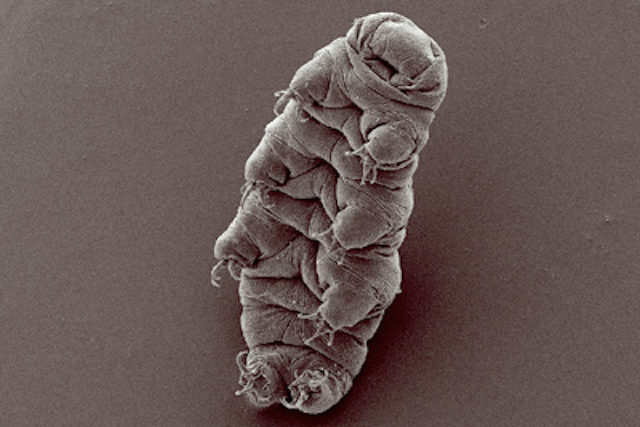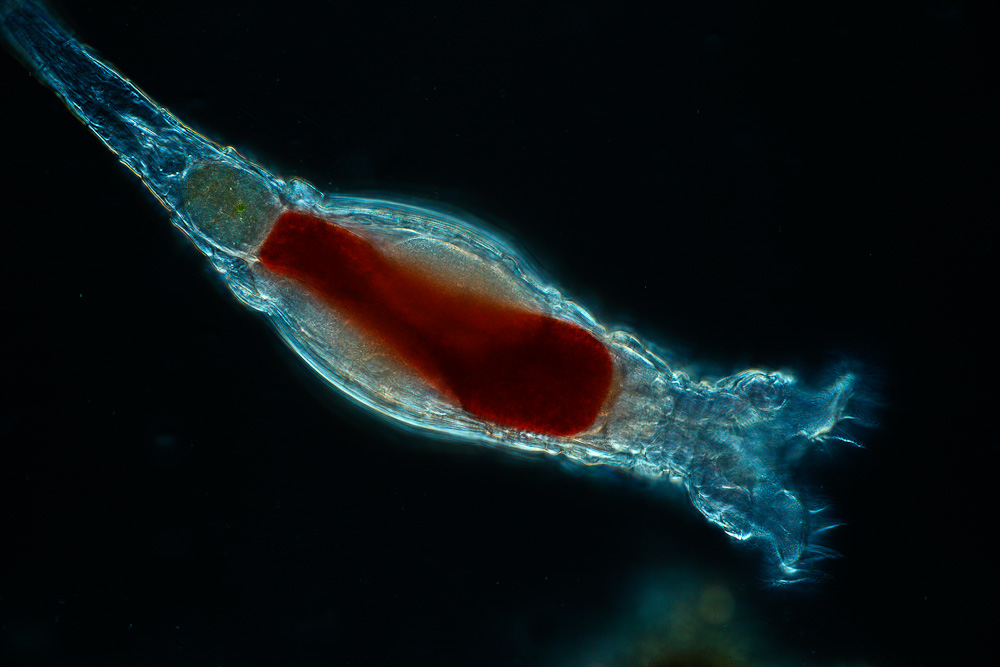In fiction, a zombie is a dead thing that is technically not a dead thing. It defies science because you can’t be both dead and walking around at the same time, so we have to suspend disbelief and go with the idea that something, somehow, has animated a corpse and allowed it to function.
In real life, death and life do have some blurry lines. We’ve all heard of zombie ants and other bugs infected with a fungus that kills them but keeps them moving. But that’s not the only thing you should be aware of. Cryptobiosis straddles the line between life and death and makes things very perplexing if you have too many preconceived notions of what life and death mean.
A team of scientists drilling near Antarctica found some ancient moss frozen in the ice they were sampling. It was 1,500 years old. Anything in the ice for 1,500 years is dead, right? Not everything.
Single-celled things, like bacteria, have been found in the ice that was between 100,000 and 8 million years old. These bacteria were revived and continued to grow, though maybe not as well as fresher ones.
But the moss that was found was far more complex than bacteria. This was a multicelled organism. Nevertheless, the team was able to revive it. It began to grow again, giving hope to the idea that older mosses, as much as 6,000 years old, could be revived again as well.
This is an example of cryptobiosis. A state of extreme inactivity or suspended animation that shuts down pretty much all metabolic function in an organism. This is typically caused by extremely adverse conditions, like being frozen in Antarctic life, and is a last-ditch effort to preserve the life of the organism. And, for some things, it can work in the most extreme conditions for a very long time.
How Does it Work?

As we mentioned, being frozen could potentially lead to a state of cryptobiosis, but it is by no means the only thing that causes it. For instance, have you ever had sea monkeys? Sea monkeys are brine shrimp, and that little packet of powder that you put in the water and stir up that turns into the sea monkeys is dehydrated brine shrimp eggs.
Brine shrimp eggs are extremely resilient and can endure cryptobiosis when they become dried out, if they’re in an extreme salt environment, or if they are in an environment completely devoid of oxygen.
Organisms like rotifers, tardigrades, seeds, some kinds of fish eggs, and yeast all experience cryptobiosis of one kind or another. Even some insects can survive it.
Normally, a living organism of any kind has some type of metabolism it relies on to stay alive. It needs to produce energy through some chemical means. Photosynthesis, digestion, whatever it is. But in cryptobiosis, their metabolism is essentially shut down, so they no longer need that energy to survive until conditions are more hospitable to life and they can revive.
Ideal conditions have to be met for the organism to revive itself, like when you put your brine shrimp eggs in water to hatch those sea monkeys. If conditions never improve, the organism may end up dying. Not all of them can live as long as that moss in the ice. Some can go months, some even several years, but rarely do any complex organisms last longer than that. Bring shrimp, for instance, may be able to survive 25 years in cryptobiosis. And tardigrades? They’re even more remarkable.
Tardigrade Survival

Tardigrades are one of the most remarkable creatures on Earth. They can survive some of the most extreme conditions ever, and, in part, cryptobiosis is part of their secret.
Tardigrades can survive the vacuum of space. In 2007, Russia took 3000 of them into space and then tossed them outside for 10 days. In the end, 68% of them had survived their time in no oxygen, exposed to cosmic radiation, and they all had normal offspring.
Other tardigrades were bombarded with radiation at doses 1,000 times higher than what would be a lethal dose to a human. The little creatures produced pigments called betalains, which counteracted the radiation damage. Injected into humans, these betalains afforded the subjects greater radiation resistance as well.
In terms of temperature extremes, tardigrades have been dropped down to 0.05 Kelvin, which is just barely above Absolute Zero (it’s -272.95 Celsius), and raised to 150 Celsius. They’ve spent 30 years in a freezer and survived pressures of 40,000 kilopascals.
Despite how hardy these little guys seem, they need water to survive properly. Remove them from water, and they dry out into something called a tun, and this is their cryptobiotic state. This is the state that allows them to survive extreme cold, heat, pressure, radiation, and even time.
In their normal, thriving state, a tardigrade may just live 8 months to a couple of years. But in cryptobiosis, they can live for over a century.
Scientists used to think a sugar called trehalose was the way tardigrades survived cryptobiosis. When other organisms dry out, they produce trehalose to stay alive. But tardigrades produce very little or none. Instead, tardigrades have specific genes and proteins that allow them to endure the extremes they face in cryptobiosis. The proteins basically form glass inside the tardigrades’ cells to keep them alive when they are in a dehydrated state. The full mechanism is still somewhat mysterious, but that covers some of it.
The thing about tardigrades is that they survive different extremes differently. Cryptobiosis is an umbrella term. For instance, when exposed to extreme cold, it’s cryobiosis that keeps a tardigrade alive. When there’s no water? That’s anhydrobiosis. If they were to find themselves in an extreme saline environment? That would be osmobiosis.
All the different kinds of cryptobiosis affect the tardigrade differently, and that means there are different functions in different mechanisms by which it happens. Each one has to be studied individually to figure out how it works. While the bioglass structures may keep them alive during anhydrobiosis, cryobiosis may involve the production of a kind of biological antifreeze, something that prevents cytoplasmic freezing or maybe even alters the kind of ice crystals formed in the cells so that they take on a state that allows the tardigrade to safely revive.
Given what a tardigrade can survive, it’s not unreasonable to wonder if anything can kill a creature in cryptobiosis, or are these organisms effectively immortal?
Immortality

Rotifers are microscopic organisms that live in freshwater. They are also remarkably hardy, even if they don’t quite reach tardigrade level. Nonetheless, a rotifer that survived cryptobiosis for 24,000 years was once brought back to life. They may be small, but they have brains and muscles and multiple cells. Before this one was found, it was believed they could only survive about a decade in cryptobiosis.
Nematodes are a kind of roundworm. Over 30,000 species have been identified, but it’s estimated there may be millions. At least one kind of nematode was frozen and Arctic Ice during the Pleistocene era and then revived in the present, 46,000 years later. How does it manage to do that? The same way we used to think tardigrades did it.
The nematode regulates a sugar called trehalose. It protects the cell membranes and allows the organism to survive the freezing cold almost indefinitely.
Basically, the sugar replaces the water in any given membrane and makes it look like it’s still hydrated because the shape is preserved, even though there’s no water left.
Tardigrades can live for about a century in cryptobiosis. We heard about moss that lived for 1,500 years, but nematodes now have the record for the longest lived.
Forty-six thousand years is certainly a long time for anything to survive. But remember, a nematode is a fairly complex organism compared to single-cell bacteria. And we already saw that some bacteria can potentially survive millions of years. If you’re curious about what the longest-lived bacteria ever are that we’ve discovered so far, you have to look at a simple bee.
Scientists found a bee preserved in amber, Jurassic Park style. The B is between 25 and 40 million years old. No, the bee didn’t come back to life, but it had bacteria in its stomach that had survived the ordeal thanks to cryptobiosis. Scientists were able to revive it, making it the oldest living organism on Earth.
In the right conditions, these organisms can survive for an extremely long time in cryptobiosis, but they are not Immortal by any means. Over 30% of those tardigrades that were left in space ended up dying. When you expose the cryptobiotic eggs of brine shrimp to heat extremes, many of them will die.
It’s worth remembering that cryptobiosis is never an ideal state for a life form. This is survival at its most extreme. It’s a last-ditch effort for an organism to hold on to life, waiting for survivable conditions to return. But if things get worse, the organism will die.
All of this is very interesting, but does it have any relevance to humanity? We saw that a tardigrade’s radiation tolerance could potentially benefit mankind, but is there any part of cryptobiosis that can help us out? Obviously, we are far too complicated to replicate something like cryptobiosis. If we’re left in extreme temperatures, extreme radiation, and extreme dehydration, we just die. But is there a way we can adapt what we know from these organisms to help us?
Human Effects

Researchers at Harvard have been studying the proteins that tardigrades use to help them survive extreme environments. The end goal is to apply them to humans to see if we can benefit from the same kind of resilience. If we could make a cell that metabolically slows down like a tardigrade going into cryptobiosis, we could prevent injuries like inflammation or even cell death from happening.
If the same kind of proteins that tardigrades use can be adapted to humans, then conditions like strokes, heart attacks, sepsis, and more could be stopped in their tracks.
Other research is focusing on that radiation resistance and how it could be used to aid astronauts on long space missions. More than that, with the potential development of novel and faster space travel, cryptobiotic species have been considered as new astronauts. Organisms we can send into space over vast distances for long periods, while they stay preserved, so we can learn how they endure the rigors of space travel. Then we can attempt to apply that knowledge to future manned missions to ensure humans are better able to survive as we explore further and endure harsher conditions.
Anhydrobiosis is being looked at to aid with crops and food storage. We could prevent spoilage and allow crops to grow in harsher conditions if we could adapt these techniques to our food supply.
Trehalose, that sugar that other organisms besides tardigrades use, has also been used to help humans. It can be used to preserve platelets and vaccines that have to be transported around the world in emergencies. It’s not working on an entire organism, but it does the same job to keep things viable, a science adapted from the understanding of cryptobiosis.
Trehalose was first used in the ’80s to preserve drugs that treated fungal infections. They were preserved with the sugar, and then a squirt of water would activate it and make it usable.
There is a wide range of applications that various forms of cryptobiosis could offer. These include space travel, medical advancements, and potential adaptations to climate change and food production. There are likely many more applications no one has even considered yet that could be applicable once the process is better understood. The good thing about the future of cryptobiosis is that we have evidence that time is not necessarily a problem. What’s another 46,000 years or so?